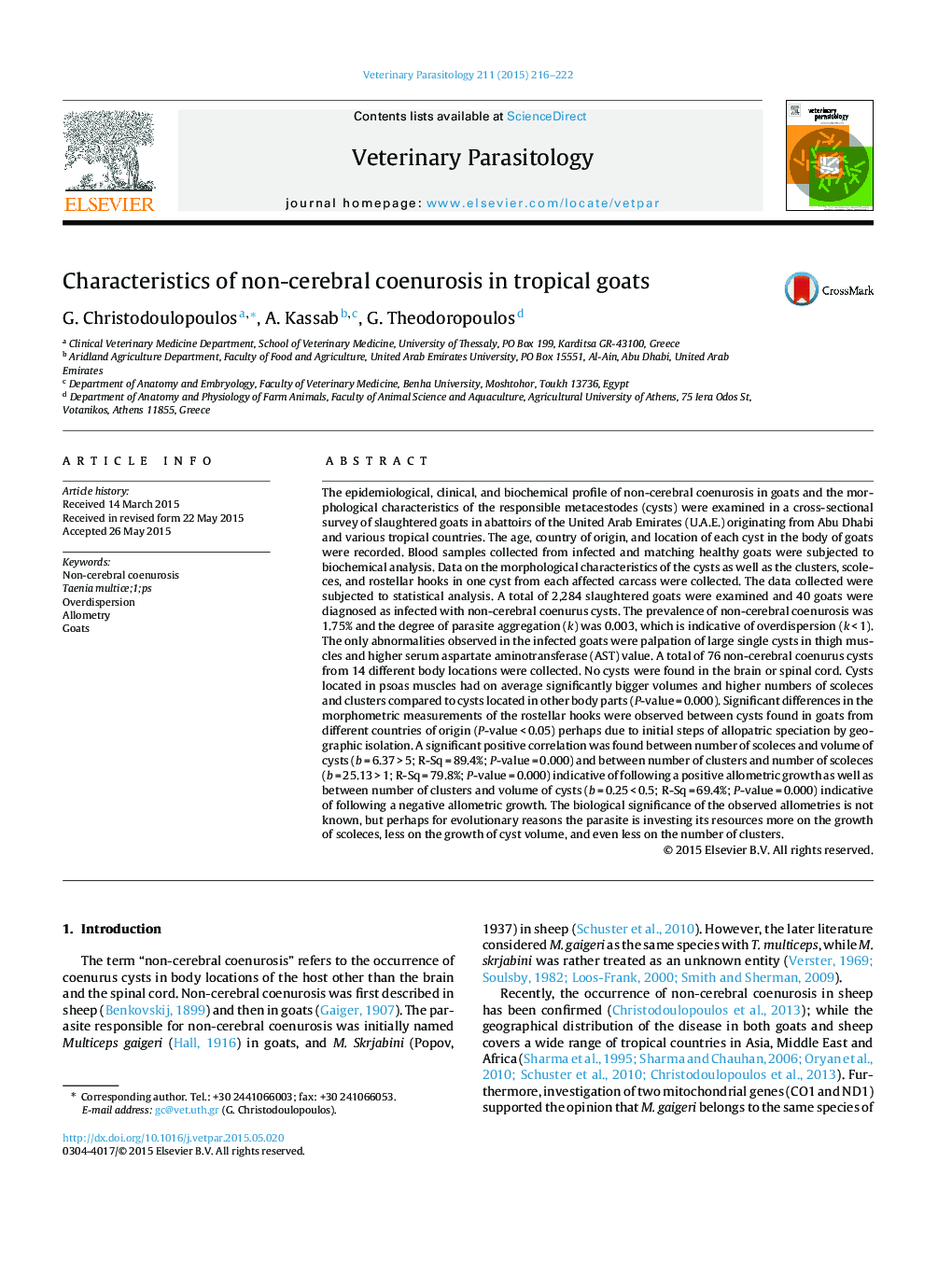| کد مقاله | کد نشریه | سال انتشار | مقاله انگلیسی | نسخه تمام متن |
|---|---|---|---|---|
| 5802418 | 1555668 | 2015 | 7 صفحه PDF | دانلود رایگان |
- The prevalence of non-cerebral coenurosis was 1.75% and the degree of parasite aggregation (k) was 0.003, which is indicative of overdispersion.
- In the goats affected with non-cerebral coenurosis, no cysts were found in the brain or spinal cord.
- No abnormalities in test blood values or clinical signs were observed in goats affected with non-cerebral coenurosis, except the palpation of large single cysts in thigh muscles.
- Significant differences in the morphometric measurements of the rostellar hooks were observed between cysts found in goats from different countries of origin (P-value < 0.05), perhaps due to initial steps of allopatric speciation by geographic isolation.
- A significant positive correlation was found between number of scoleces and volume of cysts and between number of clusters and number of scoleces indicative of following a positive allometric growth as well as between number of clusters and volume of cysts indicative of following a negative allometric growth.
The epidemiological, clinical, and biochemical profile of non-cerebral coenurosis in goats and the morphological characteristics of the responsible metacestodes (cysts) were examined in a cross-sectional survey of slaughtered goats in abattoirs of the United Arab Emirates (U.A.E.) originating from Abu Dhabi and various tropical countries. The age, country of origin, and location of each cyst in the body of goats were recorded. Blood samples collected from infected and matching healthy goats were subjected to biochemical analysis. Data on the morphological characteristics of the cysts as well as the clusters, scoleces, and rostellar hooks in one cyst from each affected carcass were collected. The data collected were subjected to statistical analysis. A total of 2,284 slaughtered goats were examined and 40 goats were diagnosed as infected with non-cerebral coenurus cysts. The prevalence of non-cerebral coenurosis was 1.75% and the degree of parasite aggregation (k) was 0.003, which is indicative of overdispersion (k < 1). The only abnormalities observed in the infected goats were palpation of large single cysts in thigh muscles and higher serum aspartate aminotransferase (AST) value. A total of 76 non-cerebral coenurus cysts from 14 different body locations were collected. No cysts were found in the brain or spinal cord. Cysts located in psoas muscles had on average significantly bigger volumes and higher numbers of scoleces and clusters compared to cysts located in other body parts (P-value = 0.000). Significant differences in the morphometric measurements of the rostellar hooks were observed between cysts found in goats from different countries of origin (P-value < 0.05) perhaps due to initial steps of allopatric speciation by geographic isolation. A significant positive correlation was found between number of scoleces and volume of cysts (b = 6.37 > 5; R-Sq = 89.4%; P-value = 0.000) and between number of clusters and number of scoleces (b = 25.13 > 1; R-Sq = 79.8%; P-value = 0.000) indicative of following a positive allometric growth as well as between number of clusters and volume of cysts (b = 0.25 < 0.5; R-Sq = 69.4%; P-value = 0.000) indicative of following a negative allometric growth. The biological significance of the observed allometries is not known, but perhaps for evolutionary reasons the parasite is investing its resources more on the growth of scoleces, less on the growth of cyst volume, and even less on the number of clusters.
Journal: Veterinary Parasitology - Volume 211, Issues 3â4, 30 July 2015, Pages 216-222
